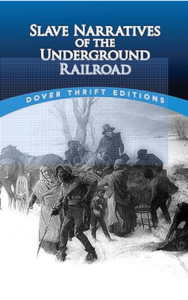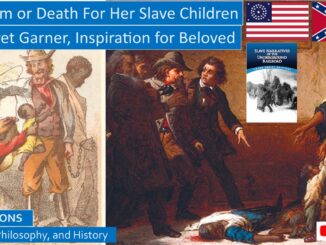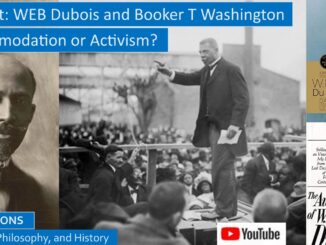
Today we will tell the tale of one of the most famous conductors on the Underground Railroad, the ex-slave Harriet Tubman, who again and again went back to her native Maryland to lead more slaves to their freedom.

YouTube video for this blog: https://youtu.be/Lkk30_zIDIO
Harriet Tubman was born as a slave in Maryland in the 1820’s, often beaten and whipped by her overseers, causing permanent scars. When she was a little girl an overseer threw a heavy metal weight at another slave, it bashed her skull instead. This injury caused dizziness, pain, and spells of hypersomnia, or excessive sleep, that lasted all her life. Soon after her injury, she started experiencing strange visions and vivid dreams that she interpreted as messages from God due to her Methodist upbringing.[1]
Harriet Tubman was illiterate, and unlike many who escaped slavery, never learned how to read and write. She shared her experiences with Sarah Beford, who wrote her early biographies.
Harriet Tubman remembers: “I grew up like a neglected weed, ignorant of liberty, having no experience of it. Then I was not happy or contented: every time I saw a white man I was afraid of being carried away. I had two sisters carried away in a chain gang, one of them left two children.”
“I think slavery is the next thing to hell. If a person would send another into bondage, he would, it appears to me, be bad enough to send him into hell, if he could.”
Their white owners were always distrustful of their slaves, always suspicious that they would be plotting to escape. Harriet remembers that on the plantations, “Slaves must not be seen talking together,” “their communication was often by singing” “the familiar hymns, telling of the heavenly journey to the land of Canaan” and freedom.
“When dat ole chariot comes,
I’m gwine to lebe you,
I’m bound’ for de premised land,
Frien’s, I’m gwine to lebe you.”
When Harriet Tubman’s master died, many of his slaves wondered: Would families be split up on the slave auction block? Would they eventually be sold to a cruel master who owned hundreds of slaves in the Black Belt, the new plantations from Georgia to Alabama?
Harriet Tubman heard her interior voice whispering, “Arise, flee for your life!” In her visions of the night, she saw the horsemen coming, and heard the shrieks of women and children, as they were being torn from each other, and hurried off no one knew whither.”
Later she would gain the reputation as the Moses of her people, bringing them back to the Promised Land of Freedom. But on her initial escape, Harriet did not know the way, she just knew to start walking north, trusting in the Lord to lead her. “Her brothers started with her, but the way was strange, the north was far away, and all unknown, the masters would pursue and recapture them, and their fate would be worse than ever before; and so, they broke away from her, and bidding her goodbye, they hastened back to the known horrors of slavery, and the dread of that which was worse.”
Harriet was determined to reach the Promised Land of Freedom. She remembers, “I had reasoned dis out in my mind; there was one of two things I had a right to, liberty, or death.” “No man should take me alive; I should fight for my liberty as long as my strength lasted, and when de time came for me to go, de Lord would let dem take me.”
Day after day she hid, night after night she walked northwards. Either by her “native cunning or God-given wisdom, she applied to the right people for food, and sometimes shelter, though often her bed was the cold ground, and her watchers the stars of night.”
Soon after she reached Pennsylvania and freedom, she found work at odd jobs, working day and night, saving up for another trip South to rescue more slaves, starting with her relatives, but many were reluctant to take the journey. “Suddenly and mysteriously, she appears some dark night at the door of one of the cabins on a plantation, where a trembling band of fugitives, forewarned as to time and place, were anxiously awaiting their deliverer.”
“Then she piloted them North, traveling by night, hiding by day, scaling the mountains, fording the rivers, threading the forests, lying concealed as the pursuers passed them. She, carrying the babies, drugged with paregoric, in a basket on her arm.”
Harriet Tubman remembered: “The way was so toilsome over the rugged mountain passes, that often the men who followed her would give out, and foot-sore, and bleeding, they would drop on the ground, groaning that they could not take another step.” “Then the revolver carried by this bold and daring pioneer would come out, and while pointing it at their heads she would say, ‘Dead niggers tell no tales; you go on or die!’ And by this heroic treatment she compelled them to drag their weary limbs along on their northward journey.” Later she proclaimed that she never lost a passenger on her Underground Railroad.
After spiriting so many slaves to freedom, a massive bounty of $40,000 was placed on her head, which is equivalent to many hundreds of thousands in today’s money, enough to buy hundreds of slaves. If she had been caught, she likely would have been lashed with a hundred lashes bleeding out, she likely would have died from the punishment. She was bold, she would go to the market pretending to be an old woman, once she brushed past one of her former masters!
Before the Civil War, she made nineteen trips to Maryland to rescue more enslaved relatives, and slaves on other plantations. In this account she remembers she rescued three hundred souls from slavery, other accounts say close to a hundred.[2] In 1850, to try to save the Union, Congress passed the Fugitive Slave Act of 1850, which permitted slave owners to pursue runaway slaves, requiring that citizens of free states cooperate in this hunt. This meant that Harriet Tubman escorted her escaping slaves over the border to Canada, the new land of freedom.[3]
In our Yale Lecture Notes, we reflected on how Harriet Tubman assisted with a Northern Union military raid on the rice plantations on the South Carolina coast where seven hundred slaves were rescued on steamboats. During the Civil War she served as a Union scout and spy and helped nurse many soldiers and runaway slaves back to health.
Stories of How Slaves Helped the Union Win the Civil War: Yale Lecture Notes
http://www.seekingvirtueandwisdom.com/stories-of-how-slaves-helped-the-union-win-the-civil-war-yale-lecture-notes/
https://youtu.be/89ulb20cy8Q
Since Harriet Tubman had no official title or salary, she received only a minimal pension after the war. She eventually purchased a farm in New York and continued to take in boarders. Though she received income from well-wishers and proceeds from her biographies penned by Sarah Bedford, her charity meant she lived in poverty. Fortunately, one of her charitable works was the founding of an old folk’s home for freed slaves, where she herself lived out her last days before she passed away in 1913, living until her nineties.[4]
DISCUSSING THE SOURCES
This very readable account of her life varies in detail from the account in Wikipedia, which is likely the more accurate account. But both accounts likely drew primarily from Sarah Bedford’s several accounts of the life of Harriet Tubman, written at different times in her life. We will be reviewing many of the stories about slaves escaping to freedom in the Underground Railroad, and there are other slave narratives. Frederick Douglass escaped from slavery when the abolition movement began. Augustine Tolton and his mother escaped from slavery during the Civil War, he was the first black priest ordained after the Civil War. And Booker T Washington was emancipated as a young teenager at the end of the Civil War.
Frederick Douglass Tells Us About His Life as a Slave in his Autobiography
http://www.seekingvirtueandwisdom.com/frederick-douglass-tells-us-about-his-life-as-a-slave-in-his-autobiography/
https://youtu.be/7VkzhyNnuQk
Life and Times of Frederick Douglass, After Slavery as an Abolitionist
http://www.seekingvirtueandwisdom.com/life-and-times-of-frederick-douglass-after-slavery-as-an-abolitionist/
https://youtu.be/M0sx85oMRQA
Father Augustine Tolton, From Slave to Priest
http://www.seekingvirtueandwisdom.com/father-augustine-tolton-from-slave-to-priest/
https://youtu.be/dZbzWJkAf5k
Up From Slavery: Autobiography of Booker T Washington
http://www.seekingvirtueandwisdom.com/up-from-slavery-autobiography-of-booker-t-washington/
https://youtu.be/yxDnJ6sBoJc
In our first video in this series, Harriet Jacobs sailed for freedom after hiding for many years on her plantation.
Underground Railroad: Harriet Jacobs, the Slave Girl Who Escapes Slavery Before the Civil War
https://seekingvirtueandwisdom.com/underground-railroad-harriet-jacobs-the-slave-girl-who-escapes-slavery-before-the-civil-war/
https://youtu.be/3KMkAyg7goY
We read of Eliza Harris who escaped with her infant daughter crawling from one block of ice to another, crossing a river not quite frozen over in the winter, with slave catchers watching helplessly on the bank. This incident inspired a scene in Harriet Beecher Stowe’s Uncle Tom’s Cabin, a novel that helped spark the Civil War.
Underground Railroad: Eliza and Her Infant Escape Slavery Over the Ice Before the Civil War
https://seekingvirtueandwisdom.com/eliza-harris-and-her-infant-escapes-slavery-over-the-ice/
https://youtu.be/kRSzNZP73og
[1] https://en.wikipedia.org/wiki/Harriet_Tubman
[2] Slave Narratives of the Underground Railroad (Garden City, New York: Dover Publications, 2001, 1861), Harriet Tubman, pp. 183-188, they quote Sarah Bradford, Harriet Tubman: The Moses of Her People (Mineola, New York: Dover Publications, 2004, 1869 and 1886)
[3] https://en.wikipedia.org/wiki/Fugitive_Slave_Act_of_1850




1 Trackback / Pingback